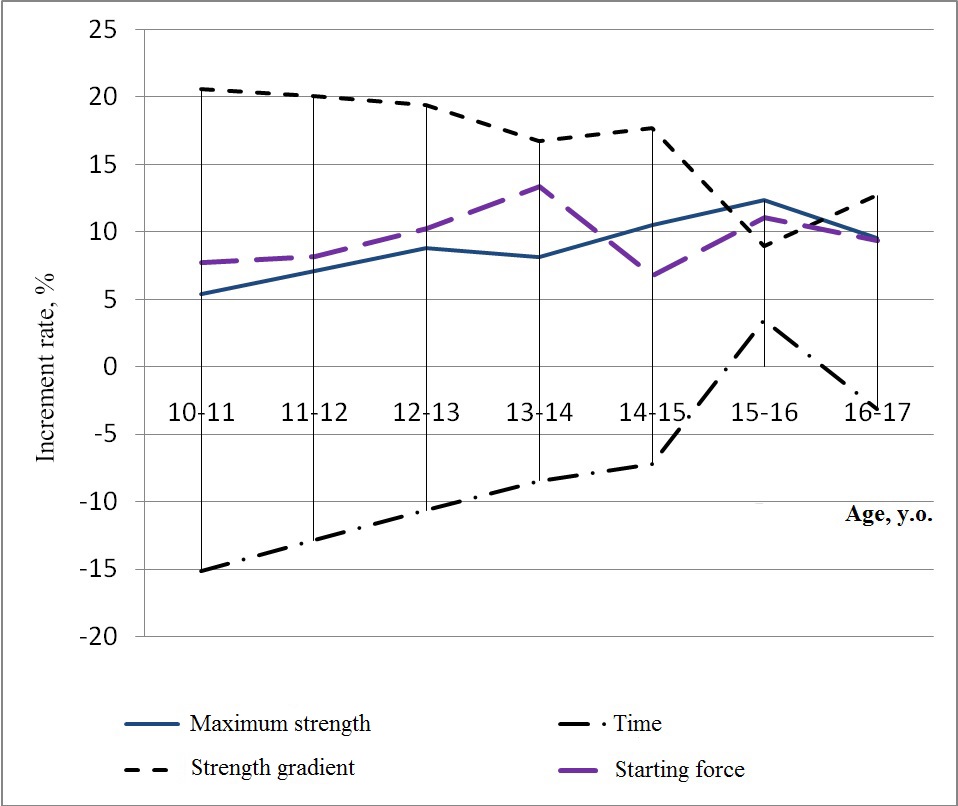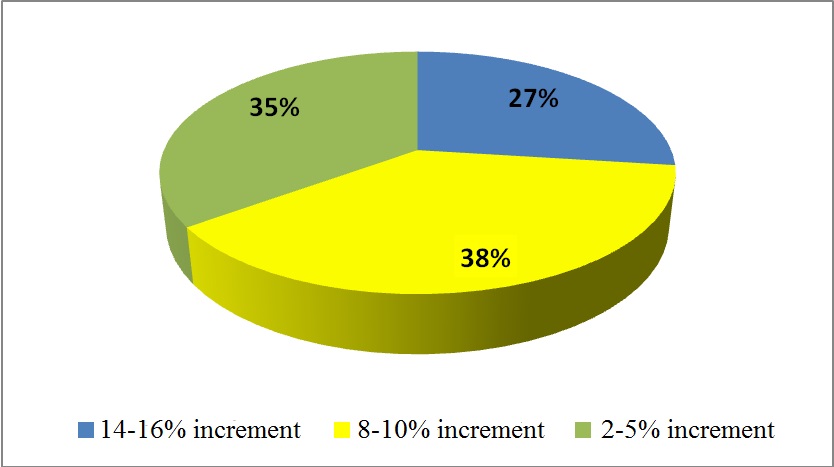Testing dynamic component of strength ability in 10-17 year-old footballers
Фотографии:
ˑ:
PhD O.V. Zlygostev
Tobolsk Industrial Institute, branch of Tyumen Industrial University, Tobolsk
Keywords: junior footballers, annual training cycle, strength abilities, dynamic component, strength gradient.
Introduction. Training of young athletes is to be based on an orderly uninterrupted training method contributing to development of sport skills, enhancement and ultimate implementation of athletes’ functional capabilities [2]. The problem of increase of effectiveness of the training process is closely related to the optimal use of sports training methods and means [1, 5]. The means and methods used to develop strength and speed-strength abilities, which are instrumental in the achievement of sports mastery, are especially important for footballers [3, 4].
Thus, objective of the study was to complete a set of system tests to obtain the strength ability variation data and apply them for further improvement of the education and training stages of 10-17 year-old footballers within an annual training cycle.
Organization of the study. The study was carried out at the premises of Football Children and Youth Sports School No 2, Tobolsk, Tyumen region, and lasted from 2013 through 2016. The study involved 68 junior footballers of 10-17 years of age. The aim of the studies was to analyse the structure of manifestation of the dynamics of strength abilities, demonstrated by junior footballers in the isometric mode during knee and hip extension.
Results and discussion. Considering the graphs of variance of the strength component growth rates, the segments of decline and intensive growth of the studied indicators can be observed.
The researchers are especially interested in the relationship between speed and force of muscle contraction since these two physical qualities are constantly associated with movement and determine it. The manifestation of speed-strength abilities was analysed by the dynamics of the strength gradient, which is defined as a ratio of the maximal effort to the time of reaching it.
The strength gradient achieved the maximum rate of growth in junior footballers of 10-12 years of age. Its growth equaled 20.6% (10-11 years of age) and 20.1% (11-12 years of age). Obviously, this period is the most favorable for development of speed-strength abilities, due to the speed component.
The slowdown in the speed-strength growth rate was observed in the age period from 15 to 16 years. During this period, speed-strength abilities improved exclusively via the strength component, as the time indices were proved to regress.
The average values of the dynamics of strength and time were relatively lower as opposed to the strength- and speed-sensitive periods, but their simultaneous manifestation suggests that this period is also favorable for the purposeful training of motor qualities of young athletes.
The results of the analysis of the dynamic component of the junior footballers' strength abilities in three age periods of development are illustrated in Figure 1.

Figure 1. Changes in the dynamic component of strength ability in 10-17 year-old footballers.
The period between the ages of 10 and 12 years are characterized by a rapid increase in the time of reaching the maximal effort, and, as a result, high strength gradient growth rate. The starting force increases insignificantly.
The period between the ages of 12 and 14 years are characterized by lower rates of growth of the maximum strength and time to reach it, however, the combination of these two factors leads to the high rates of increase of the strength gradient. During this period there is also a rapid increase in the starting force indicators.
At the ages from 15 to 17 years, the strength characteristics improve at a fast pace, even against the background of a slight deterioration of the time component of speed-strength abilities.
As of today the dynamic patterns of the speed-strength fitness level of footballers have been studied insufficiently, some significant gaps can be found in this area. The researchers remain at odds as to the sensitive periods of development of speed-strength abilities. The conflicting opinions can probably be explained by the fact that the authors judged the manifestation of speed-strength abilities by the integral indicator - the long jump or high jump results. At the same time, the analysis of the effort development curve makes it possible to more thoroughly study the structure of manifestation of speed-strength abilities in a motor act.
The analysis of individual increment rates in terms of the speed-strength indicators revealed the following consistent patterns. Thus, individual increment rates of the dynamometric indicators in the majority of the subjects in the period between the ages of 10 and 12 years are due to reduced effort increase time, between the ages of 14 and 17 - due to a rapid increase in the maximum strength. In the period between the ages of 12 and 14, a significant variation in the growth rate of the time and strength parameters was detected.
The in-depth study of the effort increase rate variation revealed that in the period between the ages of 12 and 14 years, the average time reduction amounted to 9%. However, the distribution of individual characteristics showed that in 27% of the subjects the time of reaching the maximal effort continued to reduce at a fast pace (Figure 2). Within the year, their effort gain time decreased by 14-16%, while 35% of the subjects had it reduced insignificantly - by 3-5%, and 38% of the subjects demonstrated the average time rates - 9% (Fig. 2).

Figure 2. Breakdown of 12-14 year-old footballers by the increment in the time of reaching maximum strength within the annual training cycle.
A similar distribution of the subjects of the experiment was found in terms of the maximum strength rate. 42% had high annual increment of the maximum strength, ranging from 12 to 14%. 36% of 12-14 year-old footballers had the strength increment at the average level of 5-8%. 22% of the subjects demonstrated a slight increase in the muscle strength within the annual training cycle, which was not more than 6% (Figure 3).

Figure 3. Breakdown of 12-14 year-old footballers by the maximum strength increment within the annual training cycle.
The correlation analysis of the maximum strength and time of reaching it failed to reveal any significant interrelation between the given indicators in the periods between the ages of 10 and 12, 15 and 17 years, unlike the 12 to 14 age period.
Conclusion. The dynamometry test data showed that the period between the ages of 12 and 14 years is the most sensitive to the strength- and speed-strength training and reasonable strength and speed-strength building tools should be applied on a differentiated basis in this period to secure success of the relevant abilities development process.
References
- Antipov A.V. Formirovanie spetsialnykh skorostno-silovykh sposobnostey 12-14-letnikh futbolistov v period polovogo sozrevaniya. Dis. kand. ped. nauk [Special speed-strength abilities building process for 12-14-year-old footballers in adulthood. PhD diss.]. Moscow, 2002, 126 p.
- Guba V., Stula A., Kromke K. Podgotovka futbolistov v vedushchikh klubakh Evropy [Training process in leading European football clubs]. Moscow: Sport publ., 2017, 272 p.
- Guba V., Skripko A., Stula A. Testirovanie i kontrol podgotovlennosti futbolistov [Testing and monitoring of footballers' fitness]. Moscow: Sport publ., 2016, 168 p.
- Zlygostev O.V. Modulno-tselevoe proektirovanie skorostno-silovoy podgotovki futbolistov na etape nachalnoy sportivnoy spetsializatsii. Dis. kand. ped. nauk [Modular target design of speed-strength training process at initial sports specialization stage in football. PhD diss.]. Tula, 2013, 140 p.
- Slutskiy L.V. Upravlenie fizicheskoy podgotovkoy futbolistov na osnove sorevnovatelnoy deyatelnosti. Avtoref. dis. kand. ped. nauk [Management of physical training in football based on competitive activity. PhD Diss. abstract]. Moscow, 2009, 22 p.
Corresponding author: oleg_zlig@mail.ru
Abstract
The modern football sport reserve training systems give a high priority to strength tests to assess the player’s ability to effectively play and compete in matches. Objective of the study was to complete a set of system tests to obtain the strength ability variation data and apply them for further improvement of the 10-17 year-old footballers’ training stages within an annual training cycle. The study was designed to analyse the strength ability variation data obtained by isometric dynamometry of the knee and hip extension movement. The dynamometric test data showed that the period between the ages of 12 and 14 years is the most sensitive to the strength- and speed-strength training and reasonable strength and speed-strength building tools should be applied on a differentiated basis in this period to secure success of the relevant abilities development process.




